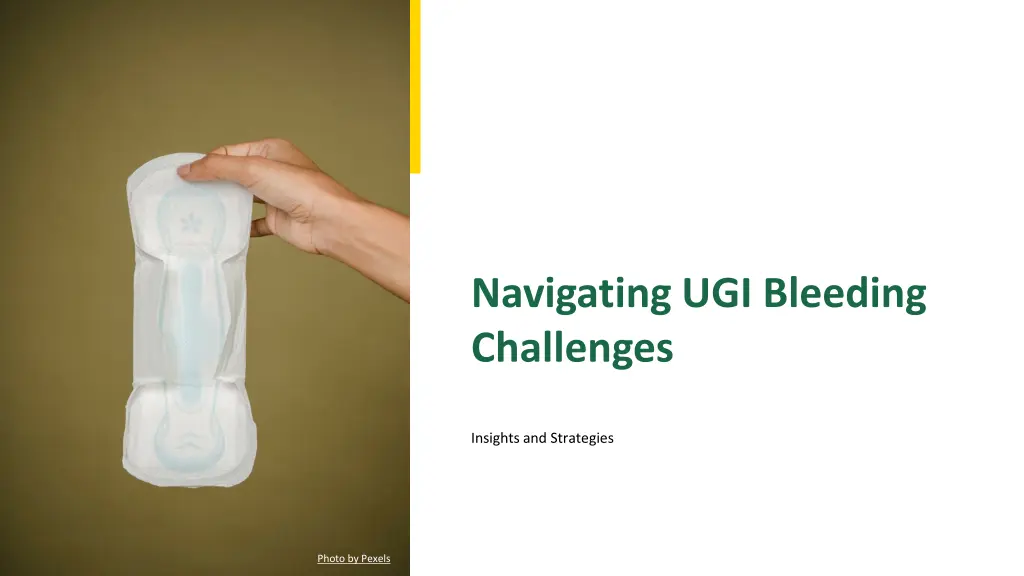
Understanding UGI Bleeding Challenges: Insights and Strategies
Explore key insights into recognizing and managing upper gastrointestinal (UGI) bleeding with this comprehensive presentation. Learn about risk profiling, common management mistakes, the Blatchford Score, key symptoms recognition, and more for effective patient care.
Download Presentation

Please find below an Image/Link to download the presentation.
The content on the website is provided AS IS for your information and personal use only. It may not be sold, licensed, or shared on other websites without obtaining consent from the author. If you encounter any issues during the download, it is possible that the publisher has removed the file from their server.
You are allowed to download the files provided on this website for personal or commercial use, subject to the condition that they are used lawfully. All files are the property of their respective owners.
The content on the website is provided AS IS for your information and personal use only. It may not be sold, licensed, or shared on other websites without obtaining consent from the author.
E N D
Presentation Transcript
Navigating UGI Bleeding Challenges Insights and Strategies Photo by Pexels
01 Understanding UGI Bleeding Table of Contents 02 The Importance of Risk Profiling 03 Common Mistakes in Management 04 Introducing the Blatchford Score 05 Recognizing Key Symptoms 06 Understanding Haematemesis 07 The Role of Emergency Endoscopy 08 Patient Demographics Matter 09 Evaluating Mortality Rates 10 Lessons Learned from Case Studies 11 The Path Forward 12 Thank You for Your Attention!
1 Understanding UGI Bleeding A Brief Overview Upper gastrointestinal (UGI) bleeding presents significant clinical challenges for medical practitioners. Identifying the right patients at risk of significant bleeding is crucial for effective management. This presentation explores key insights into recognizing and managing UGI bleeding situations. Let's delve into common pitfalls and effective tools for better diagnosis. Photo by Pexels
2 The Importance of Risk Profiling Knowing Your Patient Risk profiling helps in distinguishing between patients needing urgentintervention and those who do not. Not applying risk profiling can lead to unnecessary procedures and patientdistress. It's essential to recognize symptoms and assess overall patient history for better outcomes. Understanding the significance of clinical features is vital for decision-making. Photo by Pexels
3 Common Mistakes in Management Avoiding Pitfalls Mistakes in managing UGI bleeding can stem from misinterpretation of vital signs. Misunderstanding the clinical picture may lead to inappropriate interventions. Key examples illustrate the impact of these mistakes on patientcare. Being aware of common errors can improve clinical judgment in urgentsettings. Photo by Pexels
4 Introducing the Blatchford Score A Scoring System The Blatchford score assists in evaluating patients presenting with UGI bleeding effectively. It utilizes variables like blood urea levels and heart rate to guide clinical decisions. This score can help identify patients who may require urgent endoscopy interventions. Understanding this scoring system is essential for improving patientoutcomes. Photo by Pexels
5 Recognizing Key Symptoms Critical Signs to Watch Tachycardia and blood pressure are indicators of potential UGI bleeding. Other symptoms include haematemesis and signs of anaemia or hypovolemia. Appropriate assessment of these symptoms informs necessary immediate actions. Effective observation can significantly reduce the risk of complications. Photo by Pexels
6 Understanding Haematemesis The Clinical Picture Haematemesis can indicate severe underlying issues and needs urgentassessment. Recognizing the implications of this symptom is crucial during patientevaluation. It s essential to differentiate between severe cases and those with benign causes. Decision-making should reflect the severity indicated by the presentation. Photo by Pexels
7 The Role of Emergency Endoscopy When Is It Necessary? Emergency endoscopy is a critical procedure in cases of significant UGI bleeding. Identifying the need based on clinical parameters can save lives. This intervention allows for direct assessment and management of bleeding sources. Understanding when to act is key to effective management of UGI bleeding. Photo by Pexels
8 Patient Demographics Matter Age and Comorbidities Older patients or those with comorbid conditions face higher risks during UGI bleeding. Statistical analyses help explain variations in outcomes based on patienthealth. Tailoring management strategies to specific demographics improves care quality. A clear understanding of the patient s background is essential for effective care. Photo by Pexels
9 Evaluating Mortality Rates Trends Over Time Mortality rates associated with UGI bleeding remain stable despite advancements in treatment. Understanding these rates helps in assessing the effectiveness of current management strategies. Factors such as patient health and types of interventions contribute to these outcomes. Continued analysis is essential for future improvements in patientcare. Photo by Pexels
10 Lessons Learned from Case Studies Applying Real-Life Experiences Real cases highlight the importance of proper evaluation and management of UGI bleeding. Learning from past mistakes provides crucial insights into improving futureinterventions. Clinical experience enriches understanding and guides better decision-making. Every case is a learning opportunity for better outcomes in future situations. Photo by Pexels
11 The Path Forward Improving Clinical Practices Integrating structured assessment tools like the Blatchford score into practice can enhance outcomes. Continuous education and training on UGI bleeding management are vital for all practitioners. Engaging with updated research and protocols ensures best practices in patient care. A proactive approach can significantly reduce complications and improve care. Photo by Pexels
12 Thank You for Your Attention! Questions? Thank you for engaging in this presentation on UGI bleeding management. Your dedication to understanding these issues is vital for qualitypatientcare. Feel free to ask questions or share your thoughts for further discussion. Together, we can improve outcomes in UGI bleeding cases. Photo by Pexels
